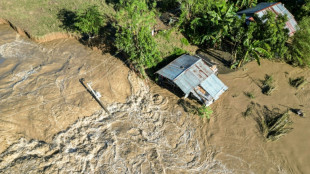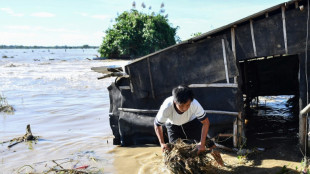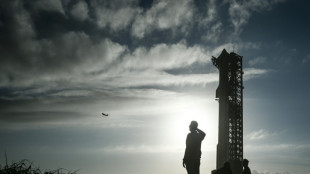
-
 NATO holds large Arctic exercises in Russia's backyard
NATO holds large Arctic exercises in Russia's backyard
-
Trouble brews in India's Manipur state

-
 Son of Norwegian princess arrested on suspicion of rape
Son of Norwegian princess arrested on suspicion of rape
-
Romanian court says 'irregularities' in influencer Andrew Tate's indictment

-
 Iran faces fresh censure over lack of cooperation at UN nuclear meeting
Iran faces fresh censure over lack of cooperation at UN nuclear meeting
-
Despondency and defiance as 45 Hong Kong campaigners jailed

-
 Scholar, lawmakers and journalist among Hong Kongers jailed
Scholar, lawmakers and journalist among Hong Kongers jailed
-
European stocks slide on fears of Russia-Ukraine escalation

-
 Police break up Georgia vote protest as president mounts court challenge
Police break up Georgia vote protest as president mounts court challenge
-
Spain royals visit flood epicentre after chaotic trip

-
 France's Gisele Pelicot says 'macho' society must change attitude on rape
France's Gisele Pelicot says 'macho' society must change attitude on rape
-
G20 leaders talk climate, wars -- and brace for Trump's return

-
 US lawmaker accuses Azerbaijan in near 'assault' at COP29
US lawmaker accuses Azerbaijan in near 'assault' at COP29
-
Tuchel's England have 'tools' to win World Cup, says Carsley

-
 Federer hails 'historic' Nadal ahead of imminent retirement
Federer hails 'historic' Nadal ahead of imminent retirement
-
Ukraine vows no surrender, Kremlin issues nuke threat on 1,000th day of war

-
 Novo Nordisk's obesity drug Wegovy goes on sale in China
Novo Nordisk's obesity drug Wegovy goes on sale in China
-
Spain royals to visit flood epicentre after chaotic trip: media

-
 French farmers step up protests against EU-Mercosur deal
French farmers step up protests against EU-Mercosur deal
-
Rose says Europe Ryder Cup stars play 'for the badge' not money

-
 Negotiators seek to break COP29 impasse after G20 'marching orders'
Negotiators seek to break COP29 impasse after G20 'marching orders'
-
Burst dike leaves Filipino farmers under water

-
 Markets rally after US bounce as Nvidia comes into focus
Markets rally after US bounce as Nvidia comes into focus
-
Crisis-hit Thyssenkrupp books another hefty annual loss

-
 US envoy in Lebanon for talks on halting Israel-Hezbollah war
US envoy in Lebanon for talks on halting Israel-Hezbollah war
-
India to send 5,000 extra troops to quell Manipur unrest

-
 Sex, drugs and gritty reality on Prague's underworld tours
Sex, drugs and gritty reality on Prague's underworld tours
-
Farmers descend on London to overturn inheritance tax change

-
 Clippers upset Warriors, Lillard saves Bucks
Clippers upset Warriors, Lillard saves Bucks
-
Acquitted 'Hong Kong 47' defendant sees freedom as responsibility

-
 Floods strike thousands of houses in northern Philippines
Floods strike thousands of houses in northern Philippines
-
Illegal farm fires fuel Indian capital's smog misery

-
 SpaceX set for Starship's next flight, Trump expected to attend
SpaceX set for Starship's next flight, Trump expected to attend
-
Texans cruise as Cowboys crisis deepens

-
 Do the Donald! Trump dance takes US sport by storm
Do the Donald! Trump dance takes US sport by storm
-
Home hero Cameron Smith desperate for first win of 2024 at Australian PGA

-
 Team Trump assails Biden decision on missiles for Ukraine
Team Trump assails Biden decision on missiles for Ukraine
-
Hong Kong court jails 45 democracy campaigners on subversion charges

-
 Several children injured in car crash at central China school
Several children injured in car crash at central China school
-
Urban mosquito sparks malaria surge in East Africa

-
 Djibouti experiments with GM mosquito against malaria
Djibouti experiments with GM mosquito against malaria
-
Pulisic at the double as USA cruise past Jamaica

-
 Many children injured after car crashes at central China school: state media
Many children injured after car crashes at central China school: state media
-
Asian markets rally after US bounce as Nvidia comes into focus

-
 Tens of thousands march in New Zealand Maori rights protest
Tens of thousands march in New Zealand Maori rights protest
-
Five takeaways from the G20 summit in Rio

-
 China, Russia ministers discuss Korea tensions at G20: state media
China, Russia ministers discuss Korea tensions at G20: state media
-
Kohli form, opening woes dog India ahead of Australia Test series

-
 Parts of Great Barrier Reef suffer highest coral mortality on record
Parts of Great Barrier Reef suffer highest coral mortality on record
-
Defiant Lebanese harvest olives in the shadow of war


Ukrainian 'princesses' pine for home in Czech castle
Ukrainian seamstress Olga Shandyba had never lived in a castle until she fled war for the Czech Republic. Now she would give anything to leave the fairy-tale lodgings and return home.
The 37-year-old is among 22 Ukrainian women and children being housed at a 14th century castle in the western Czech Republic after fleeing the Russian invasion of their homeland.
"We never expected to live in a castle," Shandyba told AFP.
"Our children are like princesses. We are like princesses. For them it's an adventure," she said. "It is an adventure for us too in a way."
The Becov nad Teplou castle is home of the St Maurus Reliquary, a cherished 13th-century artifact said to contain the remains of St John the Baptist, among others. It is considered by some the second most valuable artifact in the country after the Czech crown jewels.
Becov is now also home to a dozen Ukrainian refugee children and 10 mothers of various backgrounds, including a florist, a lawyer and a piano player.
"We are very grateful for the quiet, the warmth, the kindness," said Shandyba, who fled heavy shelling in her hometown of Okhtyrka by train.
Of more than four million Ukrainian refugees fleeing the war, the Czech Republic has welcomed 300,000. The country's National Heritage Institute has earmarked 110 beds at 17 different heritage sites to provide free shelter as part of the relief effort.
- Blue and yellow -
The Institute has so far registered 66 refugees -- a third of whom are living in Becov nad Teplou, including in a dormitory normally used for out-of-town tour guides.
"This year, we will only hire local guides who have a place to stay," Becov caretaker Tomas Wizovsky told AFP.
Nastya Bidkova, a singing teacher from Ukraine's Dnipro, said it was "absolutely unexpected" to live in a castle.
"We felt very lucky when we arrived at night and saw a beautiful castle with our flags out of the window. It was really nice," she told AFP.
Becov had no problem sourcing Ukrainian flags as blue and yellow were the colours of its former owners, the Questenberg family, Wizovsky said.
"We had them in store and could fly them almost the instant the decision was taken to show our solidarity," he said.
The town of Becov nad Teplou, with fewer than 1,000 inhabitants, has welcomed more than 60 Ukrainian refugees over the past month.
Housed in hotels, pensions and private homes as well as the castle, the children now attend the local school. The town is also taking care of visas and essentials like linen and towels, as well as jobs which, however, are hard to find.
The refugees received a free tour of the castle with all its gems and the town held a get-together to welcome the newcomers.
- 'Didn't talk' -
The children have begun to relish the opportunity and shake off their fears.
"For the first two days they didn't talk, they were timid, too quiet after all their suffering and travel," Wizovsky said.
"Now they are normal children."
But despite the hospitality, the shadow of the Russian invasion looms large. The children's mothers often look worried, smiles are rare, and they opt to indulge in odd jobs to keep their minds from wandering.
"Yes, they are living in a castle, but there's certainly no bonus involved," Wizovsky said.
Bidkova said she would rather swap the experience for Ukraine. "To get back to our families and our men who are fighting for peace over there," she explained.
Shandyba too said she wanted to return to her own house.
"If it's still standing," she added.
R.Chavez--AT
